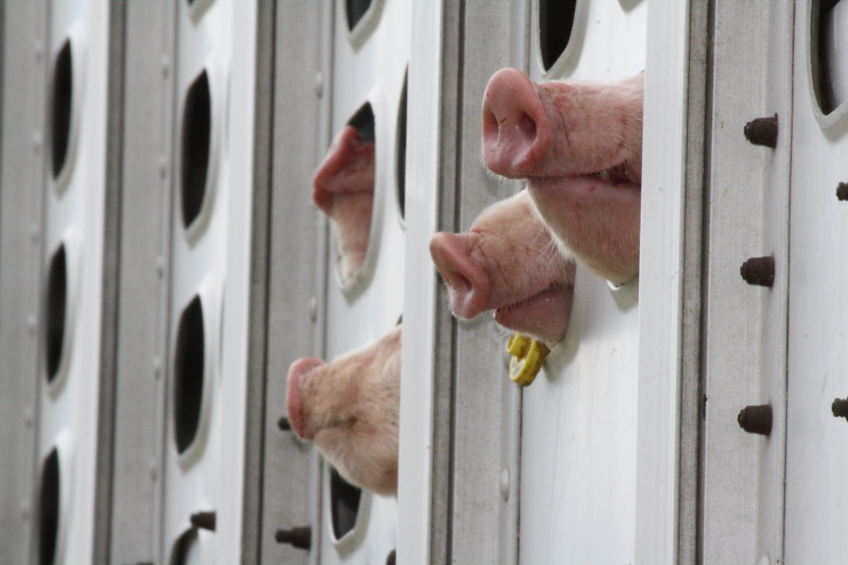Perfect storm PEDv can be stopped by biosecurity

The spread of Porcine Epidemic Diarrhoea (PED) has been a perfect storm. This is because while affected pigs shed very high levels of virus that survived well in the environment, the infective dose was very low so naïve herds were easily infected.
By Jake Waddilove, veterinarian, UK
So to stop this ‘perfect storm’? Good sow immunity from natural infection or feedback will reduce the clinical impact. Licensed vaccines are available, and appear to reduce clinical disease and virus shedding on infected farms. However, biosecurity is the only real way of stopping spread. It will reduce the impact on affected farms and will be a key to clinical recovery and virus elimination especially on larger farms. Producers need to achieve the highest possible levels of biosecurity, leveraged by good buy-in and compliance from management, their staff and their suppliers.
Remember PEDv is very good at ‘hitching a ride’ so it spreads easily. A high proportion of this spread has been by pig transport, and so is the first target of biosecurity, however we must remember there are many other means of spread.
All other transport is a risk, from feed to dead-haul, to service vehicles, to dung removal. Perhaps the next biggest risk is people, on their clothes, on their boots and on anything they bring to the unit. PEDv spreads on any equipment or inanimate objects brought to the unit. The virus has been shown to be transmitted by feed and can be spread mechanically by birds, other animals and insects. Aerial spread has been demonstrated, but only over short distances and is unlikely to be a major factor.
For biosecurity to be effective against PEDv and also Porcine Deltacoronavirus (PDCov), behaving in a similar but slightly less destructive way, there must be good planning, good procedures, good training and good tools.
Planning
Biosecurity plans for the pig business must be thoroughly reviewed at all levels using a risk based approach involving the veterinarian, management and staff. Starting with transport, scheduling is vital, with breeding herds preferably having dedicated transport, and anyway being at the top of the biosecurity pyramid. If possible have different transport for infected and free farms. Personnel movement is another target area, with staff sharing avoided and movement only down the pyramid.
Advisers, management and field staff are all increased risks as they move more between units. Delivery and entry of equipment needs planning, as do removal of dead pigs, dung and any other waste. Control of birds, rodents, insects and other animals should be reviewed. Finally in planning there is another good rule we need to aim at, never share anything between positive or negative units, be it transport, personnel or equipment.
Procedures
Perhaps one of the biggest improvements in biosecurity has been the better understanding and use of lines of separation between clean and dirty areas. This has to happen throughout the production system, for example between the loading chute and pig transporter, between the dirty and clean sides in a Danish entry system, or between the ground and the cab of a feed delivery vehicle. All the relevant lines of separation have to be identified and correct procedures for achieving separation established and used.
There are many other procedures that need complying with. These include such things as correct use of shower facilities, correct procedures for leaving and re-entering the farm, sterilisation or disinfection of equipment arriving at the farm, disinfection after risk vehicles have been near the farm, and contractor and staff behaviour during dung hauling.
In an infected farm, where bio-containment is being practised examples of procedures are control of staff movement around the farm, cleaning and disinfection of walkways after pig movement, correct local dung removal and flushing, and high level terminal cleaning and disinfection between batches.
Training
Buy-in and training is an integral part of any biosecurity programme. This must include management, farm staff, drivers, service personnel and visitors. They need to understand why biosecurity against PEDv is important, that it is still important, and how easily the virus spreads so they can understand what they need to do. Biosecurity coordinators must make it a prime task to train, review and retrain as needed. One challenge is high staff turnover and the need to keep up to date. Compliance is everything, and failure to comply will lead to a biosecurity breach sooner or later.
Tools
Without the right tools biosecurity will fail. A good example was the lack of good truck washes in the US in early 2014. Many trucks were not being routinely washed between slaughter plants and finishing barns, and systems which failed to do this had a higher rate of breakdowns with PED – even back to their breeding units. Good truck washes must allow dung removal, provide good cleaning and disinfection, and vitally prevent cross contamination. The provision of drying and heating for trucks after cleaning and disinfection is an advantage, but does not replace it. If heat is used 71°C (160°F) for ten minutes, it should kill PEDv on a clean truck.
Other examples of good biosecurity tools are disinfectant sprays on approach to farms, external washes to disinfect where trucks have been, remote dead pig collection, and good entry facilities such as showers or a Danish entry system.
Some of the most important tools for biosecurity are the right detergents and disinfectants for use in the cleaning and disinfection programme. Detergents are an essential part of good cleaning, and it has been shown that while washing can reduce contamination by 60%, the concurrent use of a heavy-duty detergent (Biosolve Plus – DuPont Disinfectants) decreases it by about 99%. With a high challenge, persistent virus such as PEDv this is a really important start prior to disinfection.
The choice of disinfectant is vital, it needs to be active against PEDv, but also have a broad spectrum of activity against other pig pathogens because we still need to control them. The disinfectant Virkon S (DuPont Disinfectants) has an independently tested broad spectrum of activity. It was identified as a disinfectant effective against PEDv by a team around researcher Andreas Pospischil in 2002, and more recently has been tested under a 5% organic load to produce complete inactivation of PEDv at dilutions of 1:200 and 1:600 at 5°C indicating that it is highly active against the virus (test results available). The properties of this disinfectant would make it the disinfectant of choice in a PEDv biosecurity programme at all levels from slaughter plant to truck wash to farm gate to farrowing house.
Infected farms
Once a breeding farm is infected, and after the initial spreading of infection by feedback, why do we need to control spread by biosecurity? First there is an ethical duty to stop other farms being infected. In the future this will be an important part of regional eliminations. Then, especially on large breeding farms, the control of spread from pockets of infected pigs will prevent other pigs being infected and further increasing the virus challenge. This biocontainment will be a key to eliminating the virus from the farm. In nursery and finisher farms a good terminal biosecurity programme should eliminate the virus. Finally a recovered farm will need to stop itself being reinfected, either from its own pig flows, or elsewhere.
Biosecurity works
Dr Doug MacDougald and Sunterra Farms finishing about 350,000 pigs in north western Iowa, a high challenge area for PEDv, have shown that effective biosecurity can prevent PEDv infection. Challenged since May 2013, good external biosecurity has meant that only 22 of 175 nursery and finisher sites were infected up to July 2014, and a further 13 by positive nursery pig movements. They have also showed that PEDv elimination from infected nursery and finisher sites can be achieved. The total of 35 infected farms were subjected to a thorough cleaning and disinfection programme and then had negative pigs placed in them. Only 6% of these clean-ups failed.
In short – the spread of PEDv in the US in 2013 and 2014 has been a ‘perfect storm’. Developing sow immunity can contain the storm, but it can only be stopped by good biosecurity. This biosecurity needs planning, incorporating good procedures and training, plus good tools and has to be leveraged by the use of the right disinfectants. There is an extra benefit from the efforts made to achieve the biosecurity needed to control PED, other disease spread has been better controlled, as can be seen from lower spread of PRRS in the first half of 2014.











